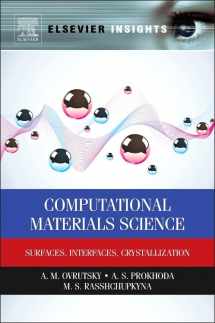
Computational Materials Science: Surfaces, Interfaces, Crystallization (Elsevier Insights)
Book details
Summary
Description
Computational Materials Science provides the theoretical basis necessary for understanding atomic surface phenomena and processes of phase transitions, especially crystallization, is given. The most important information concerning computer simulation by different methods and simulation techniques for modeling of physical systems is also presented. A number of results are discussed regarding modern studies of surface processes during crystallization. There is sufficiently full information on experiments, theory, and simulations concerning the surface roughening transition, kinetic roughening, nucleation kinetics, stability of crystal shapes, thin film formation, imperfect structure of small crystals, size dependent growth velocity, distribution coefficient at growth from alloy melts, superstructure ordering in the intermetallic compound.
Computational experiments described in the last chapter allow visualization of the course of many processes and better understanding of many key problems in Materials Science. There is a set of practical steps concerning computational procedures presented. Open access to executable files in the book make it possible for everyone to understand better phenomena and processes described in the book.


We would LOVE it if you could help us and other readers by reviewing the book
Book review



